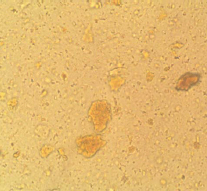About the chemical structure:
| Chemical name: | magnesium euxanthate |
| Formula: | C19H16O11Mg · 5 H2O |
| Refractive index: | above 1.52 |
Color:
| Color Index (C.I.) | this is not considered a pigment anymore because of the banned production method |
How can you identify Indian yellow?
Imaging:
UVF: yellow
IRFC: pale red
OM: yellow crystalline particles with a deep rich,translucent orange/yellow hue. Anisotropic and exhibiting weak birefringence. Particles can vary greatly in shape depending up on their manufacture from rods to spherulite to appearing like a gel. Particles can vary in size from 1-30μm.

Microscopic appearance at x500 mag
Analytics:
It's identified by means of FTIR and Raman. It is decomposed by hydrochloric acid. When burned, it should leave white ashes, as many organic substances do.
Raman spectra: University College London;
FTIR spectra: IRUG;
Usage and handling:
| Permanence: | Toxicity: |
|---|---|
lightfast: good Degradation processes: it was used in both oils and water based mediums, however direct sunlight will result in slight photoxidation and therefore fading. |
non toxic. It is no more commercially available |
Literature:
Artists’ Pigments A Handbook of Their History and Characteristics, Vol. 1, L. Feller, Ed., Cambridge University Press, London 1986, p. 9-36
Baer, N.S., Indictor, N. and Joel, A. The Chemistry and History of the Pigment Indian Yellow, Conservation and the Graphic Art, 1972 Congress of the International Institute of Conservation, Lisbon 1972, p. 401-408
(intro) - Cadmium yellow/red - Chrome yellow - Cobalt yellow - Indian yellow - Lead-tin yellow - Lemon yellow - Naples yellow - Orpiment - Yellow ochre

